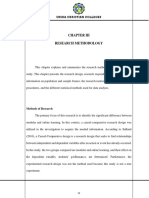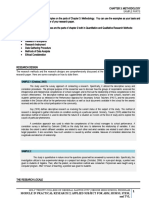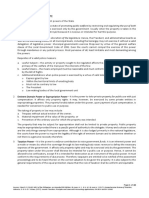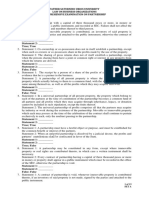Chapter 3 FINAL
Chapter 3 FINAL
Uploaded by
KeziaCopyright:
Available Formats
Chapter 3 FINAL
Chapter 3 FINAL
Uploaded by
KeziaOriginal Description:
Copyright
Available Formats
Share this document
Did you find this document useful?
Is this content inappropriate?
Copyright:
Available Formats
Chapter 3 FINAL
Chapter 3 FINAL
Uploaded by
KeziaCopyright:
Available Formats
34
Chapter III
METHODOLOGY
This chapter presents the research design, the locale and the respondents chosen
for this study, the sampling methods used by the researchers, the data instrument, data
gathering techniques used, and the applicable data treatment.
3.1 Research Design
A descriptive research methodology was used in this study to determine the
characteristics of the target population. A survey was made to a selected sample from the
population of students and graduates that have undergone On-the-Job Training of the BS
Accountancy program of Mindanao State University Iligan Institute of Technology. The
sample was obtained from the current fifth year BS Accountancy students (S.Y. 2014-2015)
and graduates of the same course (S.Y. 2014-2013 and S.Y. 2012-2013). The respondents
answered the questions through a survey questionnaire.
Based on the results obtained from the respondents, quantitative analyses were then
employed to examine the relationships between their demographics and the variables of
interest. A comparative analysis was also made to determine whether there are significant
differences between the results obtained from respondents among the three batches.
3.2 Locale of the Study
This research is conducted at Mindanao State University Iligan Institute of
Technology (MSU-IIT) located at Andres Bonifacio Avenue, Tibanga, Iligan City and at the
respondents own addresses in different areas of the country.
3.3 Respondents of the Study
The BS Accountancy students of MSU-IIT undergo OJT in their fourth year in
college. They enroll the subject on a summer and the training lasts for 250 hours. The
students select a firm or institution and then apply for OJT. Since this study involves the
assessment of the effectiveness of the OJT, the sample was selected from those who have
recent OJT experience.
35
The respondents of this study are those who have undergone OJT for the past three
years. This would mean that respondents are from fifth year students of S.Y. 2014-2015, and
students who are now graduates of S.Y. 2013-2014 and S.Y. 2012-2013.
3.4 Sampling Method
To minimize the use of estimation as to the actual number of students per batch, the
researchers obtained a list of the number of students for S.Y. 2014-2015, 2013-2014, and
2013-2012 from the MSU-IIT Department of Accountancy.
From the total number of the students and graduates who have undergone the OJT
program of MSU-IIT, a sample size was determined using the Slovins formula:
n=
N
1+ N e 2
Where: N = population size
n = sample size
e
= margin of error
Using a population size of 137 students and a tolerable error of 10%, the computed
sample size was 58. This served as the minimum number of respondents to be gathered by
the researchers. To obtain a sample that is representative of the total population, the
researchers decided to have a Stratified Sampling method. Stratification is appropriate in
order to make proportionate and meaningful comparisons between sub-groups of the
population (Gay, 1987).
3.5 Data Instrument
The data instrument used in this research is a 94-item survey questionnaire. The
survey questionnaire was used for the application of scientific procedure for obtaining data
from the respondents. The questionnaire (See Appendix 1 Survey Questionnaire) provided
the researchers a script for presenting a standard set of questions and response options. It
36
was designed to solicit the demographic profile of the respondents and measure the
different variables of interest for this study.
The approach used in scaling the responses in the survey questionnaire was the
four-point Likert-type rating scale. Likert scaling is a bipolar scaling method, measuring
either a positive or negative response to a statement.
In measuring the awareness of the respondents regarding OBE they were evaluated
based on three areas: their knowledge on the existence of OBE, the implementation of OBE
system in Higher Education Institutions (HEIs) and the impact of OBE compared to the
traditional system. The Likert items offered were Highly Aware, Moderately Aware, Slightly
Aware and Not Aware.
As to the perception of the respondents with regards to OBE, they were asked
questions that are intended to measure whether they believe that this kind of system will
create a mindset towards a clear direction of learning. They were also asked if they believe
that OBE will be useful in providing skills necessary for the industry. The Likert options
provided were Strongly Agree, Agree, Disagree, and Strongly Disagree.
The limitations are some of the factors that could possibly affect the implementation
of OBE. The respondents were asked whether they agree or disagree that these factors
indeed have an impact if the academe are evaluating to apply OBE. The Likert choices for
this part were Strongly Agree, Agree, Disagree, and Strongly Disagree.
For the competence variable, the respondents were asked to evaluate their technical
skills, analytical skills, intellectual skills, interpersonal skills, communication skills,
organizational and business management skills and ethics or values that were gained during
their training. The respondents were given choices using the Likert Scale, indicative of their
agreement or disagreement to the statements about the mentioned areas of competence.
The variables used in the competence section were tailored from the monograph of
American Accounting Association titled Intentional Learning: A Process for Learning to Learn
in the Accounting Curriculum. This monograph discusses learning to learn in terms of the
process and attributes of intentional learning. Included in the monograph is a multiple profile
of abilities needed by accounting graduates which was used as competence variables.
37
To identify the plans and preferences of the respondents and measure the level
these variables, the respondents were asked whether they prefer long-term OJT than shortterm. They were also asked if the Department of Accountancy should have official partners
in sustaining the OJT of the upcoming students of the program. The Likert options used
were Strongly Agree, Agree, Disagree, and Strongly Disagree.
As part of this study on effectiveness of the OJT program of MSU-IIT, the
researchers also intended to determine the constraints that put limit to the effectiveness of
the training undergone by students. The respondents were asked whether the time allotted
for OJT is enough for training. Respondents were also asked if the calendar shift that will be
implemented for school year 2015-2016 could possibly affect the OJT of the students. The
Likert choices used for this part were Strongly Agree, Agree, Disagree and Strongly
Disagree.
Table 3.5.1: Summary of Questionnaire Items
Part
Number of Items
Respondents Profile
Part I
Awareness
15
Perspective
Limitations
Part II
Competence
51
Plans and Preferences
Constraints
3
Total
94
38
3.6 Pilot Testing
To assess the reliability of the survey questionnaire, a pilot test was conducted to 11
random fifth year BS Accountancy students of MSU-IIT. They were asked to rate their
awareness and perception to OBE; they were also asked to rate the competence gained
from their OJT experience, their preferences, and the limits that put hindrance to the
effectiveness of the training.
The questionnaires were then retrieved, tallied and submitted to a statistician to test
the reliability using Cronbachs alpha. In statistics, Cronbach's alpha is a measure of internal
consistency, that is, how closely related a set of items are as a group. It is considered to be
a measure of scale reliability. It is most used in survey or questionnaire having a multiple
Likert scale (Laerd Statistics, 2014)
3.7 Data Gathering Procedure
After the validation and approval of the questionnaire by the statistician, these were
distributed to respondents during the last week of February. Printed copies of the
questionnaire were distributed to fifth year BS Accountancy students while those
respondents that are already graduates and are working outside Iligan City were asked to
answer an online questionnaire through Google Docs.
Researchers used stratified sampling in selecting their sample. In stratified random
sampling, the strata are formed based on members' shared attributes or characteristics. A
random sample from each stratum is taken in a number proportional to the stratum's size
when compared to the population (Investopedia, 2014). The researchers are aware that
respondents consciousness may affect their honesty and effectiveness in answering the
survey so the researchers gave the respondents the option to leave the contact number and
e-mail address unfilled. The researchers assured the confidentiality of their survey sheets.
The respondents were given enough time to respond and then the researchers gathered the
survey questionnaires.
After the questionnaires were gathered, these were then organized according to
respondents batch and tabulated. These were presented to the statistician for analysis of
any significant differences from the data obtained. The statistician was given sufficient time
to analyze the data. After a week, the statistician discussed the results with the researchers.
39
3.8 Statistical Tests Used
The Statistical Package for Social Sciences (SPSS) software was used in this
research for data analysis and interpretation. A manual statistical calculation was also made
by an expert statistician for rechecking purposes.
In describing the demographic profile of the student-respondents, the statistical
measures of frequency and percentage were used.
Analyses of the means were also made to assess the level of awareness and
perception, limitations affecting the respondents attitude towards integration of OBE;
analyses of means were also done to measure the level of competence, plans and
preferences, and the constraints affecting the effectiveness of students OJT.
In identifying whether significant relationships exist between the demographic profile
and the variables of interest, Kruskal-Wallis and Spearman Rho were used.
Kruskal-Wallis test
The Kruskal-Wallis test is a rank-based nonparametric test that can be used to
determine if there are statistically significant differences between two or more groups of an
independent variable on a continuous or ordinal dependent variable (Laerd Statistics, 2014).
Where:
H = Kruskal-Wallis Statistic
n = sample size
Ti = Sum of the ranks assigned
Spearman Rho
The Spearman Rho or Spearmen Rank Correlation is used to test the association
between two ranked variables, or one ranked variable and one measurement variable. The
40
Spearman Rank Correlation when the data have two ranked variables, and one wants to
see whether the two variables co vary; whether as one variable increases, the other variable
tends to increase or decrease (McDonald, 2014).
Where:
d = difference between the two numbers in each pair of ranks
a = number of pairs of data
= sample size
You might also like
- ERRI B12 Rp17 - 207Document10 pagesERRI B12 Rp17 - 207Dragan NedicNo ratings yet
- Monster StocksDocument4 pagesMonster Stocksallexunnder83% (6)
- Chapter 3Document3 pagesChapter 3Ella DavidNo ratings yet
- Discuss Here The Parts of The MethodologyDocument3 pagesDiscuss Here The Parts of The MethodologyPhine Alota100% (1)
- Current Problems in The Philippine Administrative SystemDocument9 pagesCurrent Problems in The Philippine Administrative SystemKeziaNo ratings yet
- Flow in 3D Packed Bed Reactors COMSOLDocument10 pagesFlow in 3D Packed Bed Reactors COMSOLBenedictEkowPrahNo ratings yet
- Maccaferri. The Use of GabionsDocument19 pagesMaccaferri. The Use of GabionsRicardo Jesus Mallma CubasNo ratings yet
- Final 3 0-1Document6 pagesFinal 3 0-1A PieceNo ratings yet
- Group4 Chapter IIIDocument4 pagesGroup4 Chapter IIIlilibeth garciaNo ratings yet
- Chapter IiiDocument7 pagesChapter Iiidada mazingNo ratings yet
- Chapter 3Document7 pagesChapter 3Diane Iris Alberto100% (2)
- pr2 Chapter3Document8 pagespr2 Chapter3Ashly MacandiliNo ratings yet
- Chapter 3 Revised BSN3C GROUP7 1Document5 pagesChapter 3 Revised BSN3C GROUP7 1Kristel AnneNo ratings yet
- Chapter 3Document4 pagesChapter 3andengNo ratings yet
- Chapter 3Document6 pagesChapter 3SingsonXDNo ratings yet
- Chapter 2 - Research MethodologyDocument3 pagesChapter 2 - Research MethodologyKim Regal Paglinawan100% (1)
- Chapter 3Document11 pagesChapter 3Abigail Jimenez100% (1)
- Research MethodologyDocument4 pagesResearch MethodologyEdeth SubongNo ratings yet
- CHAPTER III-WPS OfficeDocument2 pagesCHAPTER III-WPS OfficeYagura senpaiNo ratings yet
- Chapter III - MethodologyDocument2 pagesChapter III - MethodologyKrisk TadeoNo ratings yet
- Chapter III - MethodologyDocument3 pagesChapter III - MethodologyAlthea OrolazaNo ratings yet
- Chapter 3Document7 pagesChapter 3daryll17No ratings yet
- Chapter 3 PDFDocument7 pagesChapter 3 PDFMercy Therese Toh100% (1)
- Chapter III Sample Study No. 1Document6 pagesChapter III Sample Study No. 1Lysander KingNo ratings yet
- Chap 3 Self Confidence 123Document8 pagesChap 3 Self Confidence 123Jorie Manuel PasaolNo ratings yet
- Research Design: MethodologyDocument3 pagesResearch Design: MethodologyJackelyn GulaneNo ratings yet
- Data CollectionDocument3 pagesData CollectionRHoDY PRODUCTIONSNo ratings yet
- Chapter#3Document3 pagesChapter#3Amy BalasanNo ratings yet
- Chapter 3Document3 pagesChapter 3Raissal PototNo ratings yet
- Chapter 3Document3 pagesChapter 3Ariel DicoreñaNo ratings yet
- Chapter 3Document4 pagesChapter 3JEWEL ANN ABUNALES100% (1)
- Full Blown Qualitative Research SAMPLE GUIDEDocument48 pagesFull Blown Qualitative Research SAMPLE GUIDEhazelvillasario406100% (1)
- Chapter 3 RESEARCH AND METHODOLOGYDocument5 pagesChapter 3 RESEARCH AND METHODOLOGYNerissa PascuaNo ratings yet
- 07 Chapter 3Document6 pages07 Chapter 3Gretchen FradejasNo ratings yet
- Research Methodology: Unida Christian CollegesDocument28 pagesResearch Methodology: Unida Christian Collegeszarchaeljade garciliaNo ratings yet
- Chapter - 3 Research MethodologyDocument3 pagesChapter - 3 Research Methodologyanand_gsoft36030% (1)
- Chapter 2 Research MethodologyDocument6 pagesChapter 2 Research MethodologyshumaiylNo ratings yet
- Chapter 3Document6 pagesChapter 3Sheldon BazingaNo ratings yet
- Chapter 3 MethodologyDocument2 pagesChapter 3 MethodologyCristian James Manalo100% (1)
- Research MethodologyDocument3 pagesResearch MethodologyFhfpswh Bondoc100% (1)
- Sample Chapter 3Document8 pagesSample Chapter 3thepogi2005No ratings yet
- CHAPTER 1 ResearchDocument3 pagesCHAPTER 1 ResearchGian MonesNo ratings yet
- Research MethodologyDocument3 pagesResearch MethodologyRaven Josch GuevarraNo ratings yet
- Chapter 3Document7 pagesChapter 3Niles VentosoNo ratings yet
- Chapter 3Document7 pagesChapter 3level xxiiiNo ratings yet
- Chapter 3Document6 pagesChapter 3Daryl AlamanNo ratings yet
- CHAPTER IIIFinalfinalDocument3 pagesCHAPTER IIIFinalfinalRovin LacanalNo ratings yet
- METHODOLOGYDocument4 pagesMETHODOLOGYJohn Lewis SuguitanNo ratings yet
- Chapter 2 MethodologyDocument2 pagesChapter 2 MethodologyGlenda ValerosoNo ratings yet
- Chapter 3 MethodologyDocument9 pagesChapter 3 MethodologyMarla Andrea SimbajonNo ratings yet
- Chapter 3Document6 pagesChapter 3Julianne PalmaNo ratings yet
- Document 3 - Parts of Chapter 3 SamplesDocument10 pagesDocument 3 - Parts of Chapter 3 SamplesKreshia Kyrelle BundalNo ratings yet
- Chapter 3 Methodology and Research DesignDocument2 pagesChapter 3 Methodology and Research DesignCaelah Jamie TubleNo ratings yet
- CHAPTER-3Document7 pagesCHAPTER-3Kael ZenNo ratings yet
- Chapter IiiDocument4 pagesChapter IiiHerriet AbelNo ratings yet
- Chapter 3Document3 pagesChapter 3Mark Mangompit ArenilloNo ratings yet
- Jyrah Chapter 3 OnlyDocument9 pagesJyrah Chapter 3 Onlycris addunNo ratings yet
- CHAPTER-3Document8 pagesCHAPTER-3Deniel DacilloNo ratings yet
- Draft Chapter 3Document2 pagesDraft Chapter 3Koshi SugawaraNo ratings yet
- Chapter 3 Group 2Document8 pagesChapter 3 Group 2Charles Kevin MinaNo ratings yet
- Research Instrument SampleDocument6 pagesResearch Instrument SampleJay Jay50% (2)
- Chapter IiiDocument3 pagesChapter Iiikaycel ramosNo ratings yet
- Chapter 2 Methodology Not FinalDocument7 pagesChapter 2 Methodology Not FinalDaNica Tomboc JavierNo ratings yet
- B. Qualitative Research Research Proposal - Chapter 1 3Document19 pagesB. Qualitative Research Research Proposal - Chapter 1 3Moises David LumanogNo ratings yet
- Pilar of Mindanao: A Story of Courage and Love in World War IiFrom EverandPilar of Mindanao: A Story of Courage and Love in World War IiNo ratings yet
- GCRO Module 120 - 07 Computation of TaxDocument34 pagesGCRO Module 120 - 07 Computation of TaxKezia100% (1)
- Inherent Powers of The StateDocument20 pagesInherent Powers of The StateKeziaNo ratings yet
- Three Day Diet With PicturesDocument4 pagesThree Day Diet With PicturesKeziaNo ratings yet
- Partnership Exam Set ADocument14 pagesPartnership Exam Set AKeziaNo ratings yet
- Fernando Sainz CVDocument2 pagesFernando Sainz CVfernando_sainz_91No ratings yet
- Sample DatabaseDocument63 pagesSample DatabaseVijayan Madhavan PraveenNo ratings yet
- DesignThinkingDocument13 pagesDesignThinkingD.K.Sreekantha NMAMIT - Computer Science & EngineeringNo ratings yet
- Chapter5 SoilNailWalls 05042015Document25 pagesChapter5 SoilNailWalls 05042015Elhussain HassanNo ratings yet
- Lal Bahadur Shastri Institute of ManagementDocument35 pagesLal Bahadur Shastri Institute of ManagementLavanya sharmaNo ratings yet
- Cover Letter For Shipping Clerk With No ExperienceDocument6 pagesCover Letter For Shipping Clerk With No Experiencef634dexc100% (1)
- Training and Development Department - Sanjana - KumariDocument3 pagesTraining and Development Department - Sanjana - KumarisanjanakumarisrccNo ratings yet
- Eurocode 3: EN 1993-1-8:2005/AC:2009 + CEB Design Guide: Design of Fastenings in ConcreteDocument5 pagesEurocode 3: EN 1993-1-8:2005/AC:2009 + CEB Design Guide: Design of Fastenings in ConcretegunasekaranNo ratings yet
- 5 Trillion EconomyDocument2 pages5 Trillion EconomyAutonomo UsNo ratings yet
- Summer Training Project ReportDocument72 pagesSummer Training Project ReportShivaniChhabra100% (1)
- Geol 211 Midterm Exam Engr Moog Answer KeyDocument2 pagesGeol 211 Midterm Exam Engr Moog Answer KeyPHEBY MOOGNo ratings yet
- Proline Promass 80/83 E: Coriolis Mass Flow Measuring SystemDocument32 pagesProline Promass 80/83 E: Coriolis Mass Flow Measuring SystemwilfredoNo ratings yet
- Habile Pasword Reset With Self-Help ToolDocument12 pagesHabile Pasword Reset With Self-Help ToolYassine HaouetNo ratings yet
- 300cc (LT-F300 AK44A 1999-2000) Suzuki ATV Parts ListDocument58 pages300cc (LT-F300 AK44A 1999-2000) Suzuki ATV Parts ListMarkNo ratings yet
- Coconut Thesis PDFDocument112 pagesCoconut Thesis PDFMario Vergel Ocampo100% (1)
- NEGOTIABLE INSTRUMENT LAW-NotesDocument5 pagesNEGOTIABLE INSTRUMENT LAW-NotesGhrace Segundo CocalNo ratings yet
- Kirli A Profile of The Labor Force in Early Nineteenth Century IstanbulDocument16 pagesKirli A Profile of The Labor Force in Early Nineteenth Century Istanbulmaverick189No ratings yet
- Water Bill FebruaryDocument1 pageWater Bill FebruaryDavid HangoNo ratings yet
- Importance of Human Resource Management in An Organization: By: Amulya PDocument7 pagesImportance of Human Resource Management in An Organization: By: Amulya PVarshini NagarajuNo ratings yet
- IMFI 2020 03 TarantoDocument14 pagesIMFI 2020 03 Tarantoxuanzhengxie726No ratings yet
- Demo pc210lc-10Document30 pagesDemo pc210lc-10dani100% (1)
- RPM 120 WoodDocument2 pagesRPM 120 WoodBrava PizzaNo ratings yet
- Post Box 1905, Postal Code 211: Page 1 of 3Document3 pagesPost Box 1905, Postal Code 211: Page 1 of 3Sanyo MoosaNo ratings yet
- Final Assignment in Home EconomicDocument3 pagesFinal Assignment in Home EconomiclatigayjohnreyNo ratings yet
- Lecture 1 - Foreign Exchange Markets and Exchange Rates IDocument15 pagesLecture 1 - Foreign Exchange Markets and Exchange Rates Ijtt123100% (2)
- Crusher: C38R High Performance Cone CrusherDocument1 pageCrusher: C38R High Performance Cone CrusherFrancisco Javier López BarrancoNo ratings yet






























































































